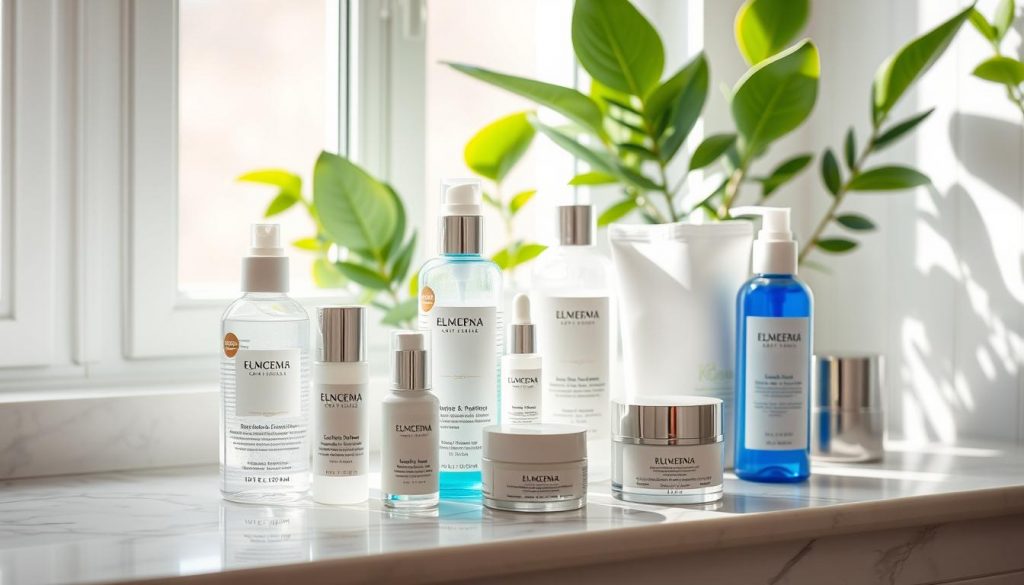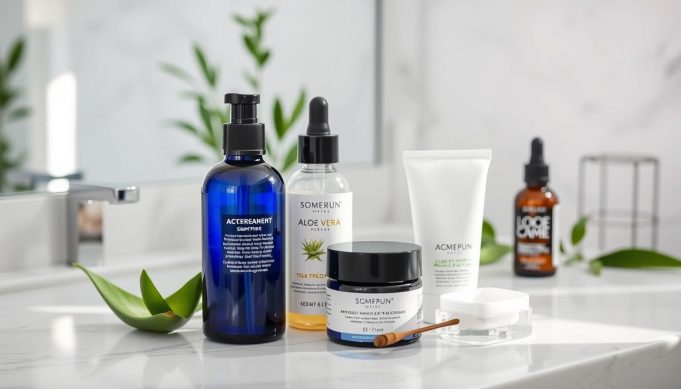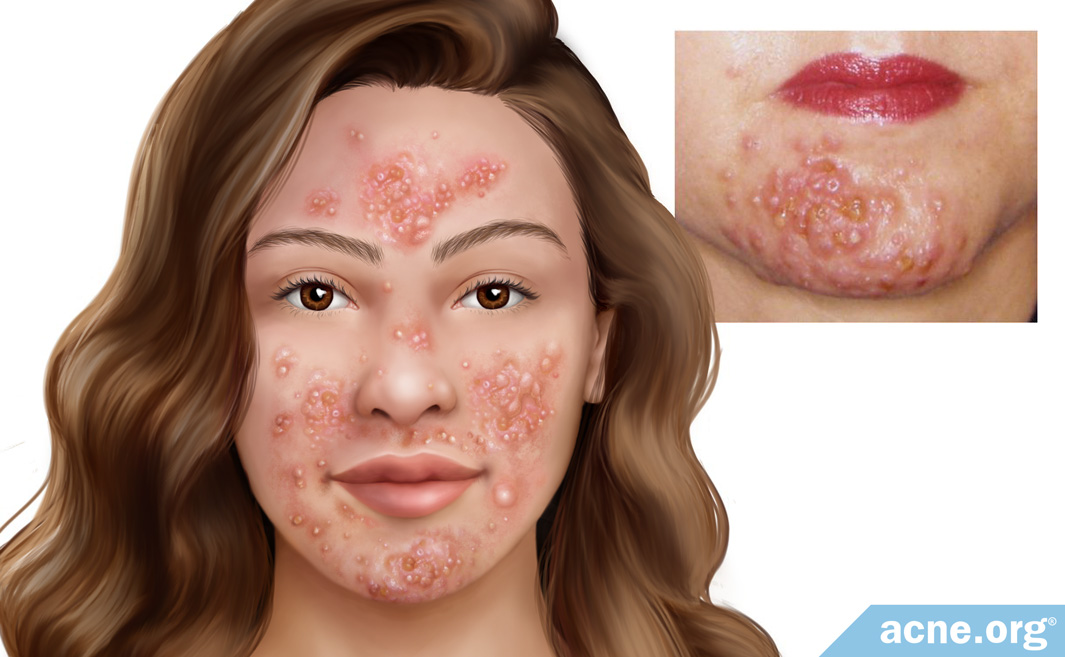Views: 3
As a teenager, I dreamed of flawless, glowing skin. But, like many, I fought persistent acne. It wasn’t until my mid-20s that I found the solution. The journey taught me about breakouts and choosing the right products for my skin.
Acne affects millions worldwide, from teens to adults1. More adults, especially women, face adult acne1. But, with the right approach, clear skin is possible.
This guide will cover acne treatments, from over-the-counter to medical options. We’ll explore how to address acne’s root causes. This way, we can find the best solution for our skin and stop breakouts.
Key Takeaways
- Acne affects millions of people, including a growing number of adults
- Mild acne can often be effectively treated with over-the-counter products
- Dermatologists recommend active ingredients like Adapalene, Azelaic acid, Benzoyl peroxide, and Salicylic acid for adult acne
- Toothpaste is not an effective acne treatment and can actually irritate the skin
- Seeking professional help from a dermatologist is recommended if desired results are not achieved within a few months
Understanding the Root Causes of Acne
Acne is a common skin issue caused by many factors. These include hormonal changes, genetics, environmental triggers, and what we eat2. The main reasons for acne are too much oil, clogged pores, bacteria, and inflammation2. It often shows up on oily areas like the face, forehead, and back2.
Hormonal Factors and Genetics
Hormonal shifts are key in causing acne2. Changes during puberty can lead to breakouts. For women, acne can last for years, getting worse just before their period2. Genetics also play a part, making some people more likely to get acne2.
Environmental and Lifestyle Triggers
Environmental factors can also cause acne2. Touching greasy things on your skin or wearing tight items can lead to breakouts2. Stress can make acne worse, especially in women3.
Diet and Skin Health Connection
What we eat affects our skin health3. Eating lots of carbs and sugar, and drinking dairy, can lead to acne3. Our gut health is also linked to acne, showing how important it is to take care of our gut3.
Knowing the many causes of acne is the first step to treating it. By tackling these causes, we can work towards clearer, healthier skin4.
Common Types of Acne and Their Characteristics
Acne comes in many forms, each with its own traits and treatment needs. Knowing the different types of acne is key to managing it well5.
Noninflammatory acne, like whiteheads and blackheads, happens when pores get clogged. Whiteheads are tough to treat because the pores are already shut5. Inflammatory acne, however, shows up as red and swollen pimples, known as papules and pustules5.
Deeper acne, like nodules and cysts, needs prescription meds to treat5. Severe nodulocystic acne can turn red or purple and scar if not treated quickly6. Acne conglobata is very severe, with many inflamed nodules, often leaving scars6.
Acne mechanica, common in athletes, is caused by heat and pressure from sports gear6. Mild to moderate acne can be managed with topical treatments like gels or creams6. For severe cases, oral meds like antibiotics or isotretinoin might be needed6.
About 17 million Americans have acne, making it a common skin issue5. Almost 85% of teens get some acne symptoms7. It’s important to know the different types of acne to treat them effectively and avoid scarring657.
Essential Ingredients in Acne Treatment Products
Understanding the key ingredients in skincare products is crucial for fighting acne. These ingredients are found in both over-the-counter and prescription treatments. They aim to tackle acne’s root causes, leading to clearer, healthier skin. Let’s look at some of the most important acne-fighting ingredients.
Benzoyl Peroxide Benefits
Benzoyl peroxide is a strong ally in the fight against acne. It kills bacteria, reduces inflammation, and unclogs pores8. Research shows that even lower strengths, like 2.5%, can be as effective as higher ones8. You can find benzoyl peroxide in strengths from 2.5% to 10% in various forms like gels, creams, and face washes9.
Salicylic Acid Properties
Salicylic acid is another essential ingredient. It exfoliates the skin, clears pores, and reduces inflammation9. You can find nonprescription salicylic acid products in strengths from 0.5% to 2% in both leave-on and wash-off forms8. It’s especially good for treating blackheads and whiteheads.
Retinoids and Their Effects
Retinoids, made from vitamin A, are also used to fight acne. They help turn over skin cells and prevent pores from clogging, making them great for all acne types and improving skin texture8. Adapalene gel (Differin) is available without a prescription at 0.1% strength8.
Other ingredients like azelaic acid, alpha hydroxy acids (glycolic and lactic acid), and adapalene also help. They unclog pores and promote skin cell turnover9. It may take 2 to 3 months of daily use to see results8. Some studies suggest combining benzoyl peroxide and adapalene can be more effective8.
Acne treatments can cause side effects like dry skin, scaling, and irritation, especially for sensitive skin8. The FDA warns of rare but serious hypersensitivity reactions from some over-the-counter products8. Always follow product instructions and see a dermatologist if side effects persist or worsen.
Knowing the key ingredients and how they work helps you choose the right skincare products. Consistency and patience are key when using these ingredients in your daily routine.
Professional Acne Treatment Options
For those with moderate to severe acne, seeing a dermatologist can really help. They use a mix of treatments to get your skin clear and healthy. This includes medicines and special procedures to fix the acne’s root causes.
Topical treatments, like stronger retinoids, can clear pores and reduce swelling10. Products with benzoyl peroxide and antibiotics fight bacteria and prevent future breakouts10.
Oral meds, like antibiotics and hormonal treatments, can also help a lot10. For really tough cases, doctors might prescribe isotretinoin (Accutane), a strong oral retinoid.
Professional treatments like chemical peels and extractions are also great11. Chemical peels, made from glycolic acid, remove damaged skin and help new skin grow11. Dermatologists do safe extractions to get rid of blemishes and find more ways to stop acne11.
Light and laser therapies, like AviClear, target acne’s causes, like too much oil and swelling12. These treatments can lessen redness, spots, and scars, showing results after several sessions11.
Working with a dermatologist is key for managing serious acne. They create custom plans using many effective treatments to get your skin clear for good12.
https://www.youtube.com/watch?v=ys_R4KZYj24
“With the right combination of prescription medications and professional treatments, even the most stubborn acne can be brought under control.”
Natural and Holistic Approaches to Clear Skin
Many people are now using natural and holistic methods to fight acne13. These methods aim to improve overall health, not just treat symptoms on the surface13.
Tea Tree Oil Solutions
Tea tree oil is a popular natural remedy for acne13. It has antibacterial and anti-inflammatory properties. Apply a small amount to blemishes to reduce redness and swelling13.
Aloe Vera Applications
Aloe vera is great for acne-prone skin13. It cools and soothes, reducing inflammation. It also helps with healing and hydration, good for acne scars and dark spots.
Honey and Cinnamon Masks
A honey and cinnamon mask is a strong acne fighter13. Honey fights bacteria and inflammation, while cinnamon controls oil. Apply to clean skin, wait 10-15 minutes, then rinse.
Green tea extracts, witch hazel, and zinc supplements are also good for acne13. They may not work as well as medical treatments but are useful in a holistic skincare plan13.
Research on holistic acne treatments is still limited13. But, many people have seen positive results by adding natural remedies to their skincare routine13. It’s all about patience and finding what works for your skin.
Daily Skincare Routine for Acne Prevention
Keeping a regular skincare routine is key to avoiding and managing acne14. Start your day by washing your face with a gentle, non-comedogenic cleanser and warm water14. Pat your skin dry and apply an acne treatment with salicylic acid or benzoyl peroxide to fight bacteria and clear pores14.
Then, use a light, oil-free moisturizer to keep your skin hydrated14. Always apply a broad-spectrum sunscreen with SPF 30 or higher to protect against the sun14. At night, clean your face again to remove makeup and prevent clogged pores14. Adding a retinoid treatment can help control skin cell turnover and reduce breakouts14.
For better results, add a weekly exfoliating treatment or mask to remove dead skin cells and enhance your glow15. Use a nourishing mask to keep your skin barrier healthy15.
Remember, achieving clear skin takes time and consistency14. It might take weeks or months to see real changes, so keep up with your routine and be gentle with your skin14.

Here are some top picks for a skincare routine that fights acne effectively:15
- CeraVe’s Acne Foaming Cream Cleanser with 4% benzoyl peroxide to clear acne while promoting skin healing16
- CeraVe’s AM Facial Moisturizing Lotion with SPF 30 to hydrate and protect your skin16
- CeraVe Resurfacing Retinol Serum to improve skin texture and reduce the appearance of acne scars16
- CeraVe’s PM Facial Moisturizing Lotion to provide essential moisture throughout the night16
By following these skincare steps and using these products, you can actively prevent and manage acne for healthier, clearer skin14.
Advanced Therapies and Medical Interventions
For those with stubborn or severe acne, advanced treatments can help. These treatments aim at the root causes of acne. They work to clear the skin and prevent future breakouts17.
Chemical Peels and Microdermabrasion
Chemical peels with salicylic acid, glycolic acid, or TCA can improve skin texture. They also reduce acne lesions17. Microneedling boosts collagen, making acne scars less noticeable17.
Light and Laser Therapy Options
Light and laser therapies, like blue light and fractional lasers, fight acne-causing bacteria. They also help the skin heal. These treatments are great for both inflammatory and non-inflammatory acne17.
Prescription Medications
For severe acne, prescription meds might be needed. Options include oral antibiotics, hormonal treatments, and isotretinoin. Always get these from a dermatologist to ensure they’re safe and work well17.
It’s key to get treatments that fit your skin type and acne. Seeing a dermatologist is the first step. They can help you find the right treatment. With the right plan, you can get back your confidence and have clearer skin17.
| Treatment | Description | Effectiveness |
|---|---|---|
| Chemical Peels | Peels with salicylic acid, glycolic acid, or TCA to improve skin and reduce acne lesions | Highly effective in improving skin and reducing acne17 |
| Microneedling | Stimulates collagen production, improving acne scars | Effective in improving the appearance of acne scars17 |
| Light and Laser Therapies | Target acne-causing bacteria and promote healing, including blue light and fractional lasers | Highly effective in managing both inflammatory and non-inflammatory acne17 |
| Prescription Medications | Oral antibiotics, hormonal treatments, and isotretinoin prescribed by a dermatologist | Effective in treating severe or persistent cases of acne17 |
Lifestyle Changes for Better Skin Health
Getting clear, healthy skin is more than just using the right products. Your lifestyle choices are key to a glowing complexion. A few simple changes can greatly improve your skin and stop acne breakouts.
Start with your diet. Eating more fruits, vegetables, lean proteins, and whole grains is great for your skin18. Also, cutting down on high-glycemic foods and dairy products can help reduce acne flare-ups18.
Managing stress is also vital for skin health. Regular exercise, meditation, and enough sleep can help control cortisol levels. This reduces the chance of acne breakouts18.
- Avoid touching your face often to stop bacteria and oil transfer from your hands to your skin18.
- Regularly clean items that touch your skin, like phones, makeup brushes, and workout gear, to keep your skin clear18.
- Drink plenty of water to keep your skin hydrated, as19 more fluid intake can greatly benefit your skin19.
- Use a broad-spectrum, oil-free, and noncomedogenic sunscreen with an SPF of 30 or higher to protect against UV rays18.
By adopting these lifestyle changes, you’re on the path to clear, healthy skin. A holistic approach that covers both your internal and external health is the secret to lasting acne prevention and a glowing complexion.

“Taking care of your skin is an investment in your wellbeing and confidence.”
Conclusion
Getting clear, healthy skin is achievable with the right approach to202122 acne management. Using topical treatments like benzoyl peroxide, salicylic acid, and retinoids20 is important. Also, making lifestyle changes and getting professional help when needed can make a big difference. Remember, treating acne takes time and patience.
It affects more than 85% of teenagers and many adults2122.
Being consistent with your skincare routine is crucial for long-term21 success. If you don’t see results after 2-3 months, it’s time to see a dermatologist. They can offer personalized advice and stronger treatments like oral antibiotics or isotretinoin2022.
Understanding the causes and types of acne is key. Using the right combination of202122 clear skin solutions can help you achieve a healthy, radiant complexion. Consistent and holistic skincare, along with professional guidance when needed, are the keys to unlocking your21 acne management success.
FAQ
What are the common causes of acne?
What are the different types of acne?
What are the key ingredients in effective acne treatments?
What are some professional acne treatment options?
What are some natural and holistic remedies for acne?
What are the key components of an effective daily skincare routine for acne-prone skin?
What are some advanced acne treatment options?
How can lifestyle factors impact acne?
Source Links
- Adult acne treatment dermatologists recommend – https://www.aad.org/public/diseases/acne/diy/adult-acne-treatment
- Acne – Symptoms and causes – https://www.mayoclinic.org/diseases-conditions/acne/symptoms-causes/syc-20368047
- Root Causes of Acne and what you can do about it? – Perfect Balance – https://www.perfectbalanceclinic.com/root-causes-of-acne-and-what-you-can-do-about-it-2/
- Acne: Types, Causes, Treatment & Prevention – https://my.clevelandclinic.org/health/diseases/12233-acne
- Types of Acne: Pictures, Treatments, and More – https://www.healthline.com/health/beauty-skin-care/types-of-acne
- Acne Visual Dictionary – https://www.webmd.com/skin-problems-and-treatments/acne/ss/slideshow-acne-dictionary
- Pimple types: 6 types of acne – https://www.medicalnewstoday.com/articles/322322
- Nonprescription acne treatment: Which products work best? – https://www.mayoclinic.org/diseases-conditions/acne/in-depth/acne-treatments/art-20045814
- 8 Best Ingredients for Acne-Prone Skin – https://www.webmd.com/skin-problems-and-treatments/acne/features/best-ingredients-for-acne-prone-skin
- Acne – Diagnosis and treatment – https://www.mayoclinic.org/diseases-conditions/acne/diagnosis-treatment/drc-20368048
- Medical Procedures for Acne – https://nyulangone.org/conditions/acne/treatments/medical-procedures-for-acne
- What Professional Treatment is Best for Acne? Uncover Solutions for Clear Skin – https://oakderm.com/dermatology-blog/what-professional-treatment-is-best-for-acne
- 11 Holistic Acne Treatments – https://vibrantskinbar.com/blog/holistic-acne-treatment/
- Behold: Your Ultimate Skincare Routine for Acne – https://www.cosmopolitan.com/style-beauty/beauty/a32239886/best-acne-skincare-routine/
- Acne Prone Skin – https://cityskinclinic.com/the-skincare-routines/acne-prone-skin/
- Clear Skin: Why You Need a Skincare Routine for Acne – https://www.cerave.com/skin-smarts/skin-concerns/acne/why-an-acne-routine-is-essential-for-clear-skin
- Treatment Modalities for Acne – PMC – https://pmc.ncbi.nlm.nih.gov/articles/PMC6273829/
- Lifestyle Tips to Tame Acne – https://www.webmd.com/skin-problems-and-treatments/acne/features/acne-lifestyle-changes
- 13 Simple Lifestyle Changes for Healthy, Vibrant Skin – https://vegasvalleyvein.com/skin-care/13-changes-for-healthy-skin/
- ACNE VULGARIS TREATMENT : THE CURRENT SCENARIO – https://www.ncbi.nlm.nih.gov/pmc/articles/PMC3088940/
- Acne: more than skin deep – https://pmc.ncbi.nlm.nih.gov/articles/PMC2585707/
- Frontiers | Acne treatment: research progress and new perspectives – https://www.frontiersin.org/journals/medicine/articles/10.3389/fmed.2024.1425675/full










